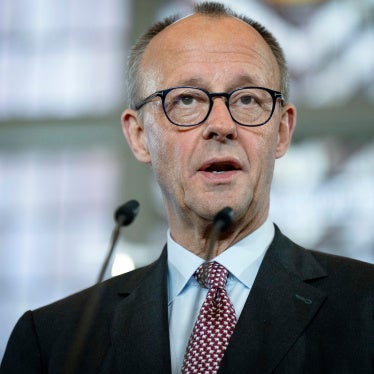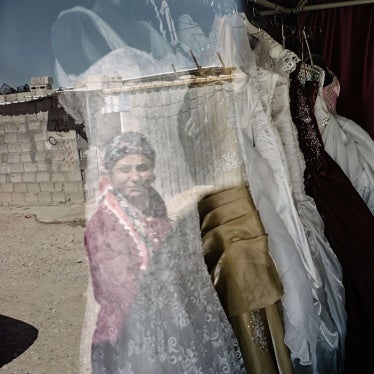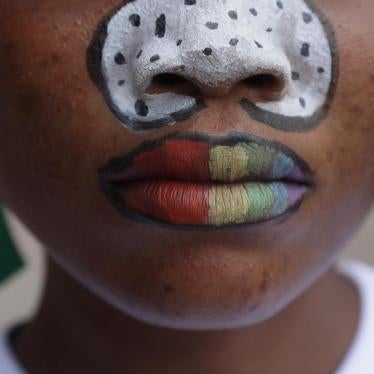Video footage clearly shows Israeli soldiers firing in the direction of the boys, Nadim Nawareh and Mohammed Salameh, and the boys falling to the ground. Medical records indicate that the two boys, as well as 15-year-old, Mohammed Azza, whom Israeli forces also shot and seriously wounded, suffered wounds to the chest caused by live ammunition. Nawareh and Salameh were shot right through the chest. Witnesses told Human Rights Watch they heard the sound of live ammunition being fired, quite distinct from the sound of rubber bullet fire, at the time the three boys were shot.
“The willful killing of civilians by Israeli security forces as part of the occupation is a war crime,” said Sarah Leah Whitson, Middle East and North Africa director. “Israel has a responsibility to prosecute the forces who targeted these teens, and also those responsible for assigning the use of live ammunition to police a demonstration.”
The Israeli military stated that it is investigating the killings but that its forces “did not use live fire,” only rubber bullets and teargas. However, rubber bullets are specifically designed not to penetrate bodies. It is highly unlikely that, at a range of at least 60 meters, rubber bullets would have caused the injuries that killed Nawareh and Salameh and wounded Azza. Nawareh’s family retrieved what may be the live bullet that killed him.
Offenses committed by Israeli security forces as part of the occupation, such as deliberate attacks on civilians, would be subject to prosecution under international humanitarian law as war crimes. Israeli forces have repeatedly shot Palestinians who posed no imminent threat with live ammunition during similar protests, including at an April 4 demonstration in the same location, and the Israeli military has a poor record of bringing soldiers to justice for such acts, Human Rights Watch said.
The boys were shot in three separate incidents but in virtually the same location in the town of Beitunia, where Palestinians had earlier held a demonstration to commemorate “Naqba Day,” which marks the expulsion of Palestinians from present-day Israel from 1947 to 1949. After the demonstration, there was a violent confrontation during which Israeli forces fired rubber bullets, live ammunition, and tear gas at Palestinians who threw rocks at the forces.
A photojournalist taking pictures at the time, Samer Nazzal, told Human Rights Watch that Israeli forces shot rubber bullets at a group of Palestinians who gathered to carry Nawareh away. Human Rights Watch viewed a series of Nazzal’s high-shutter-speed photographs taken immediately after Nawareh was shot that show a projectile, apparently a rubber bullet, coming from the direction of the Israeli forces. It struck the head of a Palestinian medic, who was wearing a bright orange vest and was part of the group carrying Nawareh.
The Israeli rights group B’Tselem reported that Israeli occupation forces also shot and wounded a 23-year-old man in the arm that day with live ammunition.
The Israeli defense and foreign ministers both suggested, and an unnamed senior defense official claimed, that Palestinians falsified video evidence of the fatal shootings, Israeli media reports said. However the officials did not provide an alternative version of events. Witness statements, medical reports, security camera videos, news media videos and photographs by journalists, which Human Rights Watch viewed, indicate that Israeli forces fired live ammunition.
The Israeli military stated that it is conducting an “operational debriefing” of the shootings, as well as police investigations. An “operational debriefing” is a military lesson-learning procedure in which officers who may be in the chain of command interview only soldiers, not other witnesses.
Israeli military police and civil police are also investigating the Israeli military and border police forces involved in the incidents. The latter types of investigations may involve witness interviews, and residents of Beitunia said Israeli investigators had visited the area of the killings and spoken to Palestinian residents several times since the killings, but had not attempted to secure it to preserve evidence. Israeli and Palestinian governments reportedly created a joint investigative committee, but no information about its mandate has been published, and the committee has apparently not yet met.
Human Rights Watch viewed video footage taken by Palestinian journalists on May 15 that shows Israeli forces at the scene with cameras, and Defense for Children International – Palestine, a rights group, said that Azza stated that he saw Israeli forces filming or photographing the clashes. To help ensure a transparent and prompt investigation, Israel should publish the full unedited videos and photographs that its forces collected, Human Rights Watch said.
“The Israeli military’s claim that its forces didn’t shoot any live ammunition on May 15 does not stand up to scrutiny,” Whitson said. “To end the impunity that this latest incident exemplifies, Israel’s allies should apply serious and sustained pressure on Israel, and Palestine should seek the jurisdiction of the International Criminal Court.”
Details of the Shootings
Israeli forces shot and wounded Azza in the chest at around 12:20 p.m., about 15 meters from where Nawareh and Salameh were later fatally shot, Azza’s father and a witness told Human Rights Watch. Israeli forces shot Nawareh in the chest at around 1:45 p.m. The bullet exited through Nawareh’s back. The Israel forces shot Salameh in the back at 2:58 p.m. The bullet exited through Salameh’s chest.
Video footage shows Nawareh throwing rocks at one point during the protest, but also shows that neither Nawareh nor Salameh was throwing rocks at the time they were shot. Human Rights Watch has not seen any video footage of Azza at the time he was shot. Azza stated he was not throwing rocks at that time. Even if the boys had been throwing rocks at the time they were shot, it seems virtually impossible that they could have posed any real threat to life considering the distance to the nearest Israeli forces, who were partially shielded by a concrete retaining wall on a hillside about 60 meters from the boys.
Witnesses told Human Rights Watch that two groups of Israeli forces were at the scene. One group of soldiers and military vehicles was approximately 230 meters away, and the other group, Border Police – an Israeli gendarmerie force, was about 60 meters from where the boys were killed. The latter group had been firing rubber bullets and teargas at Palestinian youths earlier that day, witnesses said. Human Rights Watch observations at the scene indicate that security forces at both positions would have had clear lines of fire to the location where the boys were killed.
Videos and Medical and News Reports
On May 19, Defense for Children International – Palestine published edited videos from security cameras mounted on the front of a nearby building that showed Nawareh and Salameh apparently being shot, suddenly falling to the ground, and being carried away by other protesters. The military responded with statements that “the video in question was edited in a biased way” and “does not reflect the reality of the day in question, the violence [by Palestinian protesters].” An unnamed senior defense ministry official told Israel media that it was “likely doctored.”
Human Rights Watch obtained the unedited videos from three security cameras from the rights group and spoke to Fakher Zayed, 47, who owns the cameras. Two of the cameras were focused on the area in front of Zayed’s building, and the camera videos show the boys as they were shot, while the third camera was focused on the area between the building and the nearest group of Israeli forces. Zayed has a carpentry shop on the ground floor of the building and lives in an apartment on the first floor. He said he witnessed the shootings from his balcony. The unedited videos show no evidence that the boys posed a threat to the soldiers at any point while they appear in the videos, including the moments when they were shot. The rights group B’Tselem also reviewed the full videos and published clips from two of the security cameras online.
Nawareh’s family showed Human Rights Watch a bullet that the family said his cousin found in the backpack that Nawareh is seen carrying in the video when he was shot. His father said that Nawareh went to the demonstration after attending school earlier in the day. Human Rights Watch viewed an apparent bullet hole in the backpack, bloodied schoolbooks and papers, and the bullet. The bullet is a fully jacketed, high velocity round, between 5 and 6 millimeters in diameter.
On May 22, CNN published its own video footage showing one of the Israeli border police forces stationed about 60 meters from the Palestinian protesters firing toward the location where Nawareh was killed. Seconds later, the video shows a group of Palestinians carrying Nawareh away toward an ambulance.
Some commentators and news reports have incorrectly stated that the CNN footage could not show Israeli forces shooting live ammunition because the assault rifles seen in the footage have attachments that are used to fire rubber bullets. However, the Israeli military has used at least one type of assault-rifle attachment, produced by Israel Military Industries, that allows forces to fire rubber bullets, but also to fire live ammunition without removing the attachment. A brochure states that the 22-centimeter-long “launcher” can be “attached to any rifle with NATO flash suppressor” and allows “immediate 5.56-mm lethal firing capability without removing adapter.”
Human Rights Watch could not determine whether the gunshot in the video fired a live round or a rubber bullet, or to rule out the possibility that Nawareh might have been killed by another gunshot that the video did not record.
On May 28, Israeli media reported that after reviewing the CNN footage of the protest on May 15, an Israeli military police investigation determined that a soldier from the military spokesperson’s office had fired two rubber bullets at a wall near the Palestinian demonstrators in an attempt to disperse them. The soldier had asked a border police commander to use the latter’s assault rifle, fired the shots, and returned the weapon, the investigation found. The military suspended the soldier because he was not authorized to take an active part in the crowd-dispersal operation or to fire the rubber bullets. However the investigation reportedly cleared the soldier of suspicion of firing live ammunition.
Human Rights Watch obtained medical reports dated May 15 from the Palestinian Medical Complex in Ramallah. According to the reports, Azza suffered a gunshot injury to the left anterior chest wall and the left lung. Nawareh had a gunshot injury to the chest and liver, massive bleeding, and a tear in the inferior vena cava. Salameh, whose family is also known by the last name Abu Thaher, was announced dead on arrival from a gunshot injury that entered the right side of his back and outlet from the left parasternal area, wounding his heart.
The Israeli daily Haaretz reported that unnamed “Israeli military investigators said […] the shots may have been fired by the Palestinian side, rather than by Israeli troops.” Zayed, the store owner who witnessed the shootings, said that on May 23 he overheard military officials who came to his home speaking to one another in Hebrew and speculating that a Palestinian fired the shots.
However, the victims’ entry wounds, video footage, and witness statements all strongly indicate that the shots were fired from the direction where Israeli forces were positioned. It seems highly unlikely that a Palestinian repeatedly firing an assault rifle in that area would have gone unnoticed by Israeli forces, demonstrators, and journalists who were at the scene continuously for several hours before and after the shootings.
Since September 2000, the Israeli military has convicted six soldiers for unlawfully killing Palestinians; the most severe sentence imposed was seven-and-a-half months in prison, according to the Israeli rights group Yesh Din. During that time, Israeli forces killed more than 3,100 Palestinian civilians who were not taking part in hostilities, in addition to other Palestinians killed by Israeli forces during law enforcement activities in the West Bank, according to reports by B’Tselem, another Israeli rights group.
Witness Accounts of the May 15 Killings
Nazzal, 28, a photographer and journalist for Raya news, told Human Rights Watch that he arrived at the scene at around 1:30 p.m., after the clashes had started. He later heard Israeli forces fire both rubber bullets and live ammunition. Witnesses at demonstrations, as well as Israeli, Palestinian and international human rights monitors, have repeatedly confirmed that the sound of live fire is easily distinguished from the sound of the type of rubber bullets used by the Israeli Defense Forces. Nazzal said:
There were seven or eight soldiers on foot in an elevated area, behind a concrete wall and fence, about 60 meters away. There were also a lot of [military vehicles] about 200 meters away from us. There were dozens of protesters, most of them doing nothing but watching, and about 20 others were throwing rocks. Two or three of them would run forward and throw rocks at a time, but because the soldiers were in an elevated place and shielded, none of the rocks seemed to actually hit them. They were shooting tear gas and rubber bullets constantly, and once in a while we would hear live ammunition.I started taking photos of the clashes as soon as I got there. Nadim [Nawareh] decided to cross the street. At that time he wasn’t throwing rocks; he was just crossing the street. As soon as he was in the middle of the street he was shot straight in the chest. I saw it. I was just 15 meters away from him. I heard the bullet, and he dropped to the ground and didn’t move.
Nazzal took a rapid series of photographs that show a projectile flying toward the group evacuating Nawareh, and apparently striking the head of a man wearing a medic’s fluorescent vest. The man stumbles and holds his head in subsequent images. Nazzal said:
A bunch of boys rushed to help [Nawareh] and take him away, and while they were taking him to an ambulance that was about 50 meters away, the rubber bullets and teargas never stopped. One of the ambulance men rushed to meet the boys halfway, and while he was carrying Nadim to the car, he got shot with a rubber bullet in the back of his head. He held his head and fell to the ground.
They were using teargas and rubber bullets. I was with Mohammed, a meter away from him. I heard one shot of live fire; it has a different sound from the rubber bullets. He was hit immediately. He was walking away from the clashes when they shot him. He was not in the front of the group closest to the soldiers but was moving back away from them. We picked him up and carried him to the ambulance.
Israeli forces have repeatedly used live ammunition against Palestinians during demonstrations, including recently in Beitunia, and shot Palestinians who posed no threat to them. On April 4, Israeli forces shot Mohammed Yassin, a volunteer cameraman with B’Tselem, with live ammunition while he was filming a protest in Beitunia. Video filmed by a second cameraman, which Human Rights Watch viewed, shows that Yassin was filming the demonstrations from the side of the street, was not participating, and posed no threat to Israeli forces. Yassin, who was wearing a fluorescent yellow vest, was shot in front of the same building and about 10 meters from where Nawareh and Salameh were killed. B’Tselem reported that Israeli forces shot five other people with 0.22 caliber bullets in Beitunia on April 4, and that the victims were taken to the Ramallah hospital.
Human Rights Watch documented fatal shootings by Israeli forces in the West Bank of two Palestinian boys who posed no threat to them, in January and December 2013 respectively. The military has not prosecuted anyone in either case. An autopsy recovered the bullet that killed Wajih al-Ramahi, 15, whom Israeli forces shot in the back from a distance of about 200 meters near the Jalazon refugee camp in December 2013. Al-Haq, a Palestinian rights group, said that the Palestinian authorities have not been able to transfer the bullet to Jordan for ballistic analysis because the Israeli military has not given the approval required to take it across the Israeli-controlled border crossing.








